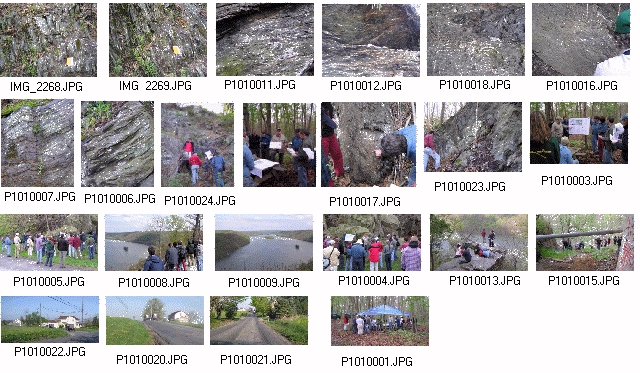
2007 Appalachian Tectonic Studies Group Field Trip
Alleghanian transpression in the mid-Atlantic Piedmont with special
emphasis on the formation of the Peach Bottom slate by dynamic retrograde
metamorphism.
Dave Valentino, State University of New York at Oswego
Alec Gates, Rutgers University
Jeff Chiarenzelli, Saint Lawrence University

Much of the mid-Atlantic Piedmont is underlain by metamorphosed sedimentary rocks that were deposited during Late Proterozoic rifting of Iapetus, then subsequently compressed and deformed during the Paleozoic prior to development of the stable passive margin. In Pennsylvania, compressive deformation during early- to mid-Paleozoic orogenesis resulted in prograde, upper greenschist to granulite grade metamorphism. Map-scale, folded-and-thrusted nappes developed during the Taconic Orogeny and was followed by late Paleozoic, dextral transpression of lithotectonic blocks during the Alleghanian Oregeny. Lateral shuffling resulted in a low-grade metamorphic overprint on the earlier, higher-grade metamorphism. The overprint is commonly seen in ductile shear zones bounding transpressional blocks. These shear zones show varying degrees of strain (see top row of photos below). The Pleasant Grove-Huntingdon Valley shear zone contains the Drumore tectonite (see map below) that is continuous along strike parallel to the structural grain of the orogen . It transects the core of the Pennsylvania reentrant and has been traced from the Delaware River to the area west of Baltimore, MD where it plunges beneath Mesozoic sedimentary cover. The Peach Bottom Formation (slate) occurs as a steeply dipping, 1- to 1.5-km wide strike belt mapped along a shear-zone splay off of the larger Pleasant Grove-Huntingdon Valley shear zone.
The first day of the field trip was spend examining outcrops of the Peters Creek and Octoraro Formations. We compared the lithologic, structural and metamorphic variations of the two Formations progressing from the NW to the SE along the Susquhanna River. We saw field evidence for dextral transpression in the western Piedmont. The second day was spent examining the Peach Bottom Slate. This is reportedly formed by dynamic retrograde metamorphism with enveloping phyllites and schists. The 30 km long slate belt is characterized by low-grade metamorphic mineral assemblages, intense deformation and attendant grain-size reduction, numerous micro-scale (100-200 µm) porphyroclasts with kinematic significance, and chemical homogeneity that occurs across the belt. Compared with enveloping phyllites and schists, the slate has a higher density and is chemically similar, yet displays some chemical traits imposed by retrograde metamorphism. The proposed origin accounts for the legendary properties of the Peach Bottom slate, the first commercial slate quarried in North America, including its unparalleled hardness, durability, and color retention after more than two centuries of use.

Since 1991, we have published a number of papers and field guides on the structural geology of the western Piedmont of Pennsylvania. Although journal articles may be readily available, some of the field guide materials may be a bit difficult to obtain. For further information contact: Department of Earth Sciences, 307 Piez Hall, SUNY Oswego, Oswego, NY 13126. 315-312-2798. Send questions or comments to dvalenti@oswego.edu.
Rev. 0508 GCH.